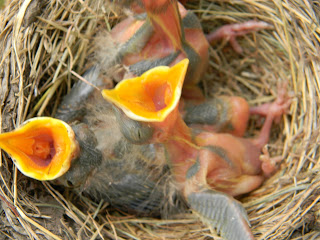Material. A picture of
the robin, blackboard drawing. A robin's nest and eggs.
Introduction.
Where have the birds been all winter? Have all the birds come back? What birds have
come? What are the first to arrive? What do they tell us?
Development.
Our American robin must not be confounded with the English robin redbreast,
although both bear the same name. It is the latter bird in whose praise so much
has been written. The American robin belongs
to the Thrush family.
Migration.
The robin is one of the earliest heralds of spring, coming as early as March,
and is one of the latest birds to leave in the autumn, many times remaining all
winter. Robins migrate singly or in flocks.
Length—about ten inches.
Head—nearly all black.
Eye—round, brown with a
white ring around it.
Bill—medium length;
curved; strong and yellow.
Throat—streaked with black
and white.
Breast—chestnut or rusty
red. The breast is brightest in the spring.
Back—dark olive gray.
Wings—brown.
Tail—black, a little
rounded; outer feathers edged with white.
Legs—slender; black.
Claws—black, slender for
perching.
Have children notice whether the
robin hops or runs.
The Nest. It is
sometimes built in the corner of a porch, but oftener it is placed upon the
horizontal limb of an orchard tree. It is so large and poorly concealed that
any boy can find it, yet it is seldom molested.
The masonry of the nest is rough and
the material coarse, being composed of moss, dead leaves, old grass, lined with
hair, and cemented with mud.
The Eggs. The eggs
number four to six, and are greenish blue in color, commonly spoken of as
''robin egg blue."
Food. The robin
feeds for a month or two on' strawberries and cherries, but generally on worms
and insects picked out of the ground.
Song. The robin is
not one of our most charming songsters, yet its carol is sweet, hearty, and
melodious. Its principal song is in the morning before sunrise, when it mounts
the top of some tall tree, and with its wonderful power of song, announces the
coming of day.
When trained, it imitates the sounds
of various birds.
In early spring the robin may be
heard at noon or in the afternoon; in summer, early in the mornings.
Robin is "the bird of the
morning."
Habits. The robin is
hardy, noisy, frolicsome, neighborly, and domestic in his habits; strong of
wing and bold in spirit. The robin courts the" society of man, following
close upon the plow and the spade, often becoming quite tame.
It destroys the larvae of many insects
in the soil.
The Young.
The young robins stay in the nest till about eleven days old. From early
morning till nearly dark the parent birds keep up a constant search for worms.
The worms are beaten up to a pulp by the parent birds before fed to the young.
The old birds only leave their little ones to eat and bathe.
QUESTIONS FOR DRILL.
What
bird comes back in April?
How
long will the robin stay?
What
is the color of robin's breast?
When
is robin's breast the brightest?
What
is the color of robin's back?
Does
robin run or hop?
What
does robin eat?
Where
does he build his nest?
Of
what is the nest made?
How
many eggs in the nest?
What
is the color of the eggs?
How
long do the young robins stay in the nest?
Who
feeds them?
READING LESSON FOR THE BLACKBOARD.
Here
is Robin.
He
has a pretty red breast.
Robin
is very happy. He is singing in the apple tree.
Mr.
and Mrs. Robin built the nest.
It
is made of leaves, grass, hair, and mud.
The
nest is big and strong.
It
holds five little eggs.
By
and by there will be five baby robins.
Mr.
and Mrs. Robin will be busy.
They
will feed the little ones.
They
will teach them to fly.
Then
the little ones will say good-bye and fly, fly, far away.






